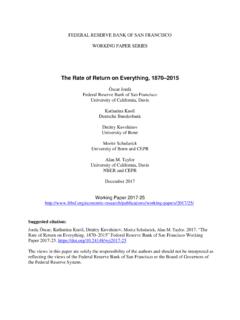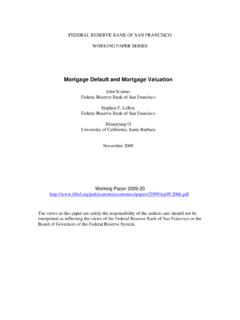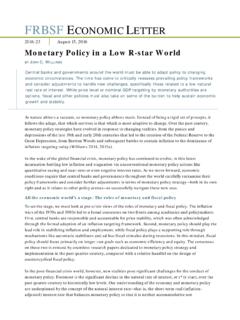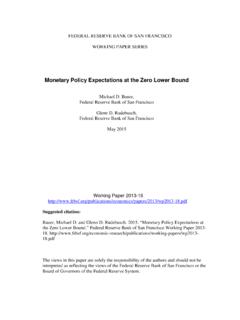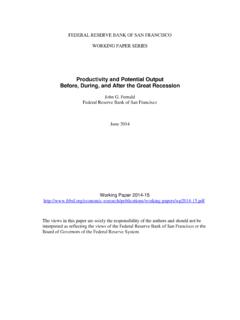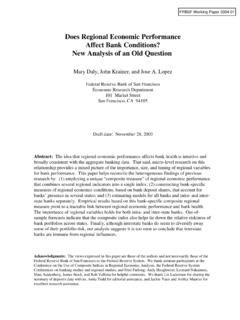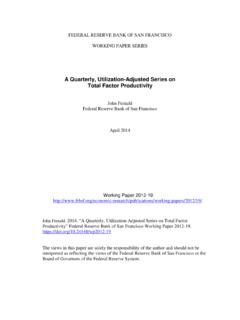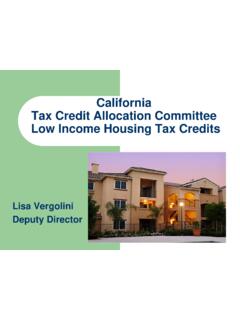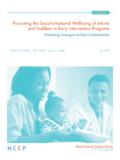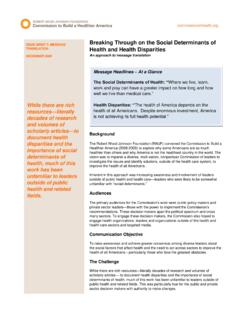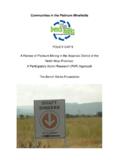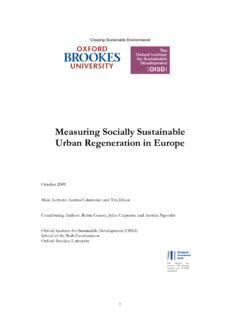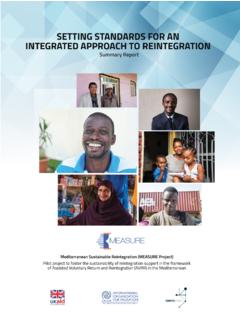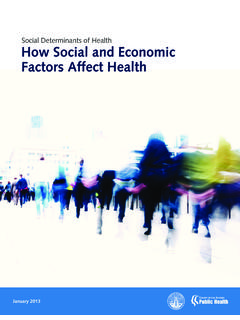Transcription of Metrics Matter: A Human Development Approach to …
1 Community Development INVESTMENT REVIEW26 FEDERAL RESERVE BANK OF SAN FRANCISCOM etrics Matter: A Human Development Approach to measuring social ImpactSarah Burd-Sharps, Patrick Guyer, and Kristen LewisAmerican Human Development ProjectI would not give a fig for the simplicity on this side of complexity, but I would give my life for the simplicity on the other side of complexity. Oliver Wendell HolmesThe Community Reinvestment Act of 1977 sprang from the federal government s commitment to end discrimination in lending and redress its enduring effects by requiring that banks support sustainable community revitalization in low-income communities.
2 The bill s sponsors hoped that ending the redlining practices that kept low-income minority communities from enjoying the range of financial services, partic-ularly credit, available to whites and pushing banks to invest in communities of color would bring the American Dream within reach of those historically excluded from its promise. In addition to the federal government, a diverse range of actors from local governments to faith-based organizations to private equity firms and social entrepreneurs are engaged in community Development financing.
3 These actors have different motivations, use different methods, and focus on different sectors, but on the whole, they seek to contribute to the same broad goal: to reduce poverty and expand economic opportunity in low- and moderate-income , members of this varied community have increasingly focused on measuring social impact. social impact is the end of a process that starts with a loan or grant (input) for an organization or individual to engage in certain activities that result in direct short-term results (outputs).
4 These outputs ideally contribute to observable changes (outcomes) that, in turn, contribute to sustainable improvements in people s lives (impacts). Inputs and outputs relate directly to the specific activities of a project; outcomes and, especially, impacts require a longer time frame and the involvement of other actors. Figure 1 charts this progression for a hypothetical investment in affordable housing. A review of efforts to measure social impact in the reveals that little such measuring occurs.
5 At best, those active in community Development financing examine inputs and outputs. Tracking information on inputs and outputs is fundamental to assessing the degree to which community Development financial institutions (CDFIs) or CRA-motivated banks are meeting their obligations to provide services to people living in low- and moderate-income neighborhoods. But a focus on inputs and outputs, while necessary, is not sufficient for assessing social impact as it leaves unasked and unanswered the most important question: what difference did these discrete actions actually make in people s lives?
6 As a result of loans Community Development INVESTMENT REVIEW27 FEDERAL RESERVE BANK OF SAN FRANCISCO made and housing units built, for instance, were fewer families homeless or doubled-up with relatives? Did the improvement in housing quality reduce asthma rates, or did greater housing stability diminish stress and enhance mental health? Did the overall quality of life in a neighborhood improve? These questions cannot be answered by looking only at inputs and outputs. Yet surely they are the questions that must be answered if we are to learn not just whether banks and other lenders are meeting their obligations under the CRA, but also what those services are yielding in terms of Human well-being.
7 Figure 1. social Impact Progression in Affordable HousingKnowing which of these impact-related questions to ask also depends on what goals the lender was seeking to advance in making the loan. Community Development is a broad term, meaning different things to different people. It may mean spurring a viable local economy. It may mean generating greater community solidarity, trust, and social capital. It may mean creating an environment more conducive to good physical health. It may mean supporting residential stability by stemming foreclosures or expanding homeownership.
8 It may mean all, or none, of these contrast to the community Development industry, the international Development field has a long history in measuring impacts. Government aid agencies in affluent democra-cies have created sophisticated measurement tools to make sure the aid they give to poor countries (using taxpayer dollars) is being used efficiently and effectively. Multilateral organi-zations, such as the World Bank and the United Nations, are increasingly focused on results to ensure they are moving toward their poverty-reduction goals, and they have developed shared tools and targets all nations can rally around.
9 The most high-profile of these efforts is of people below poverty threshold Development INVESTMENT REVIEW28 FEDERAL RESERVE BANK OF SAN FRANCISCOthe Millennium Development Goals (MDGs), a set of eight goals, each with concrete, time-bound targets, to reduce poverty and hunger, child and maternal deaths, and the prevalence of diseases such as malaria and HIV, and to increase school enrollment, women s equality, and environmental experience of the international community with the MDGs has been overwhelmingly positive.
10 Despite the significant challenges of data collection in poor countries, where statis-tical systems are often weak, the MDGs have galvanized resources and aligned the actions of an extremely disparate group of actors. Although not perfect, the goals have focused the international Development agenda, improved the process of policymaking, and instituted accountability for Human progress that in many cases was previously Although not every country will achieve every MDG goal by 2015, many have a shot, and others are far closer than they would have been without this highly visible campaign of quantifiable targets.
